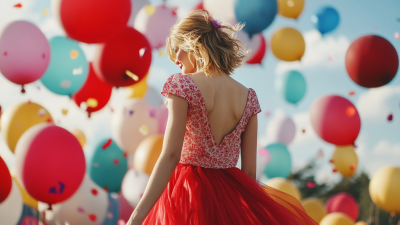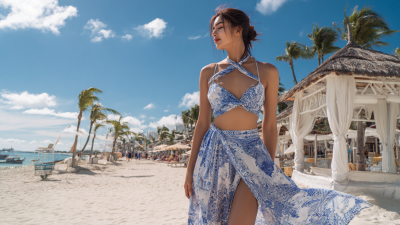Leave Your Message
The fashion industry has seen various trends rise and fall over the decades, and one of the most intriguing resurgences in recent years is the Balloon Skirt. This voluminous silhouette, which gained prominence in the 1950s, has re-emerged as a symbol of both nostalgia and modern creativity. According to a recent report by Statista, the global women’s clothing market is projected to reach $1 trillion by 2025, with niche trends like the Balloon Skirt contributing to this growth. Designers are increasingly experimenting with fabric techniques and colors, creating a vibrant appeal around this figure-enhancing garment. As consumers seek unique pieces that blend historical inspiration with contemporary styles, the Balloon Skirt stands out as a perfect example of how fashion history continues to influence modern aesthetic choices. This report explores the factors behind the rise of the Balloon Skirt trend, examining its cultural significance and the ways it has evolved within the fashion landscape.

The balloon skirt, characterized by its voluminous silhouette and dramatic flair, has a rich historical background that reflects the evolving nature of fashion. Originating in the 16th century, the concept of skirts with fullness can be traced back to the use of petticoats and crinolines, designed to enhance women's natural shapes while providing a sense of grandeur. In the 1950s, the balloon skirt re-emerged as a symbol of post-war femininity, inspired by Christian Dior’s “New Look” that celebrated an hourglass figure with luxurious fabrics and bold shapes.
Tips: When styling a balloon skirt, consider balancing the volume with fitted tops to create a harmonious silhouette. Accessories play a crucial role; a structured belt can cinch the waist, adding definition to the overall look. Don’t shy away from experimenting with textures—pairing a matte balloon skirt with a shiny blouse can create a striking contrast that enhances visual interest.
As trends evolve, the balloon skirt has found its place in contemporary fashion, often reimagined in various materials like tulle and denim, appealing to a new generation. The historical roots of this trend not only showcase its enduring charm but also inspire innovative designs that celebrate individuality and self-expression.
| Period | Key Features | Influence | Notable Designers | Cultural Context |
|---|---|---|---|---|
| 1830s - 1840s | Fullness at the bottom, use of crinolines. | Romanticism in fashion. | Dizzying patterns, intricate embroidery. | Victorian ideals of femininity. |
| 1950s | Dramatic shapes, accentuated waistlines. | Post-war optimism, femininity. | Christian Dior, Hubert de Givenchy. | Influence of Hollywood glamour. |
| 1980s | Volume and structure, use of tulle. | Power dressing, female empowerment. | Vivienne Westwood, Jean Paul Gaultier. | Rise of individuality and rebellion. |
| 2000s | Mix of casual and formal, varied lengths. | Street style, globalization. | Marc Jacobs, Miuccia Prada. | Influence of pop culture and celebrities. |
| 2020s | Sustainable materials, innovative designs. | Eco-consciousness, personal expression. | Emerging designers and influencers. | Heightened focus on individuality. |
The balloon skirt trend, characterized by its voluminous and structured silhouette, first emerged in the mid-20th century. Key designers such as Christian Dior played a pivotal role in popularizing this unique style. Dior's "New Look" collection in 1947 introduced women to a more feminine and hourglass shape, which included skirts that flared out dramatically, embodying the essence of the balloon skirt. His innovative use of fabric and silhouette transformed post-war women's fashion, making the balloon skirt synonymous with elegance and sophistication.
Another influential figure in the rise of the balloon skirt was Pierre Balmain, known for his luxurious and theatrical designs. Balmain's creations often featured exaggerated proportions and intricate details, enhancing the skirt's dramatic appeal. By incorporating the balloon skirt into his collections, he captivated the fashion world and established it as a staple for high society events. Additionally, contemporary designers like Comme des Garçons and Maison Margiela have reinterpreted the balloon skirt, blending avant-garde aesthetics with traditional elements to keep the trend alive in modern fashion.

The balloon skirt, characterized by its voluminous silhouette and cinched waist, emerged as a distinctive trend influenced by various cultural and historical factors. Rooted in the 1950s, it gained prominence as a symbol of femininity, reflecting the post-war optimism and a shift toward modernist aesthetics. According to a report by the National Fashion Association, the resurgence of vintage fashion in the past decade has seen a 40% increase in the popularity of skirts that emphasize exaggerated shapes and playful designs, such as the balloon skirt.
Cultural influences also play a significant role in the evolution of the balloon skirt. The artistic movements of the 20th century, including Cubism and Surrealism, encouraged designers to experiment with forms and structures in clothing. Contemporary fashion houses have embraced these influences, drawing from pop culture and social movements to reinterpret the balloon skirt for a new generation. Data from the Global Fashion Index indicates that styles incorporating bold silhouettes have driven a 30% increase in women's apparel sales in the last three years, showcasing the trend's relevance and adaptability in today's fashion landscape. This fusion of cultural narratives and historical references continues to shape the balloon skirt's identity, making it a staple in modern wardrobes.
Balloon skirts have undergone a fascinating evolution since their inception, with each decade bringing new interpretations that reflect the changing tastes and social dynamics of the times. In the 1950s, the balloon skirt emerged as a signature piece characterized by its voluminous silhouette, often worn with fitted bodices to create a striking contrast. This style not only accentuated the feminine shape but also symbolized post-war optimism, as women embraced a new freedom in fashion that allowed for both playfulness and elegance.
As fashion moved into the 1980s, balloon skirts took on a more exaggerated form, often paired with bold prints and vibrant colors. This era saw the rise of power dressing, and designers like Jean Paul Gaultier and Thierry Mugler incorporated balloon elements into their collections, making statements about independence and empowerment. The rebellious spirit of the time was reflected in the use of unconventional fabrics and styling, marrying traditional femininity with strong, avant-garde aesthetics.
In recent years, the resurgence of balloon skirts has redefined the trend once again, as contemporary designers experiment with digital prints and eco-friendly materials. The modern interpretation often blends vintage charm with a fresh, urban twist, appealing to younger generations seeking both comfort and individuality in their wardrobe choices. Thus, the balloon skirt continues to adapt through the decades, remaining a versatile piece that resonates with the evolving landscape of fashion.
This chart illustrates the popularity of balloon skirts in different decades, showcasing how trends have evolved over time. The data represents the percentage of fashion collections featuring balloon skirts each decade.
The balloon skirt, characterized by its voluminous silhouette and whimsical charm, has evolved from a quirky trend into a contemporary fashion staple. Modern interpretations often blend this classic design with innovative fabrics and aesthetics, creating a dynamic fusion that appeals to a wide range of tastes. Designers today play with textures, colors, and lengths, resulting in balloon skirts that can transition effortlessly from casual daywear to elegant evening attire.
When styling a balloon skirt, embrace its statement-making nature by balancing proportions. Pairing it with a fitted top can enhance your silhouette while ensuring the outfit remains chic. Opt for high-waisted balloon skirts to create an elongated frame, especially when complemented with heeled ankle boots or pointed flats. To maintain a polished look, select skirts in solid colors or subtle patterns, which can easily be dressed up or down with accessories.
Tips: Experiment with layering. A cropped jacket or a structured blazer can add sophistication to the playful volume of the skirt. Additionally, don’t shy away from mixing fabrics—lace and tulle can bring a romantic touch, while denim and cotton lend a casual vibe. Finally, choose bold accessories that stand out without overwhelming the outfit.







